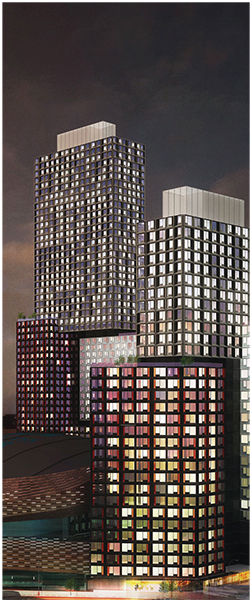Trending
COMMERCIAL


A rendering of Forest City Ratner’s residential project Pacific Park (formerly Atlantic Yards). Chinese firm Greenland Holding Group bought a 70 percent stake in the project in Brooklyn’s biggest deal of the year.
The growth of the technology, advertising, media and information sector, collectively known as TAMI, propelled Manhattan office leasing figures in 2014, but growth across the borough was not even.
Leasing activity dipped 0.5 percent in Midtown, the city’s largest office market, in 2014 from a year earlier, according to Colliers, just as Midtown South reported a 54.4 percent jump over the same period. Midtown’s trouble in attracting technology tenants, one of the fastest growing segments of the city’s economy, contributed to the area’s drop in leasing activity. Chemerie Cheng, managing director of research and consulting for Colliers International, echoed the common refrain that many technology workers are put off by Midtown’s “dated” buildings.
While it didn’t do as well as Midtown South, Midtown still saw rents rise amid the general uptick in the office market. Midtown rents ended the year at a record $74.80 per square foot last year, up 7 percent compared to the year before, while Midtown South experienced an 11 percent rise.
Meanwhile Downtown saw positive results with the largest drop in vacancy among the three office markets, with the availability rate dropping from 15.6 percent to 11.7 percent. Part of the reason was finance firms’ willingness to head south. “Three years ago, a large financial client would not consider anything below Midtown,” said Cheng, “now they are really putting Downtown on their list.”
TAMI tenants also had a big impact Downtown. They occupied a record 43 percent of the area’s office space in 2014, according to CompStak. They continued to head Downtown to find relatively affordable Class A office space, including Time Inc., which took 700,000 square feet at Brookfield Place. The hugely symbolic One World Trade Center is also starting to fill up. Employees at anchor tenant Condé Nast trooped into their new offices in November.
The commercial property boom isn’t limited to the leasing market. Building sales are also taking off with bigger billion-dollar deals sealed in 2014 compared to the year before. According to Real Capital Analytics, sales of Manhattan office buildings and retail properties respectively surged 24 percent and 129 percent in 2014 from a year before. Blackstone scored the top spot in 2014’s priciest Manhattan commercial building sale as the seller of 3 Bryant Park to Ivanhoe Cambridge and Callahan Capital Partners for $2.25 billion.
In the outer boroughs, sales of office buildings and retail properties saw an even greater surge than Manhattan, driven in part by an interesting new trend: Foreigner investors poured more than $600 million in outer-borough real estate through the first half of the year, the most ever, according to data from Real Capital Analytics. Brooklyn received the vast majority of those dollars. The trend marks a departure from foreign investors’ typical Manhattan-centric focus.
One example is Shanghai-based Greenland Holding Group, which teamed up with Forest City Ratner last year, forming Greenland Forest City Partners, to further develop the long-stalled, $4.9 billion Atlantic Yards residential project, which was renamed Pacific Park. The development’s saga took another twist when modular construction company Skanska USA Building cancelled its contract for the project in the fall.
2014 was a robust year for Manhattan’s retail market as well. Rents along 57th Street soared in 2014, thanks to super tall luxe condos like the new 96-story 432 Park. The area saw a 41 percent increase in average asking retail rents.
The Manhattan hotel market was another bright spot in 2014 as revenue surged on the back of rising occupancy and room rates. The 87 percent average occupancy rate represents a seven-year high. That came as the average room rate hit a six-year high of $288. Luxury hotels are driving demand for high-end stays, while the mid-market is responding to the competition from apartment sharing-site Airbnb.
[vision_divider style=”hr-solid”]




